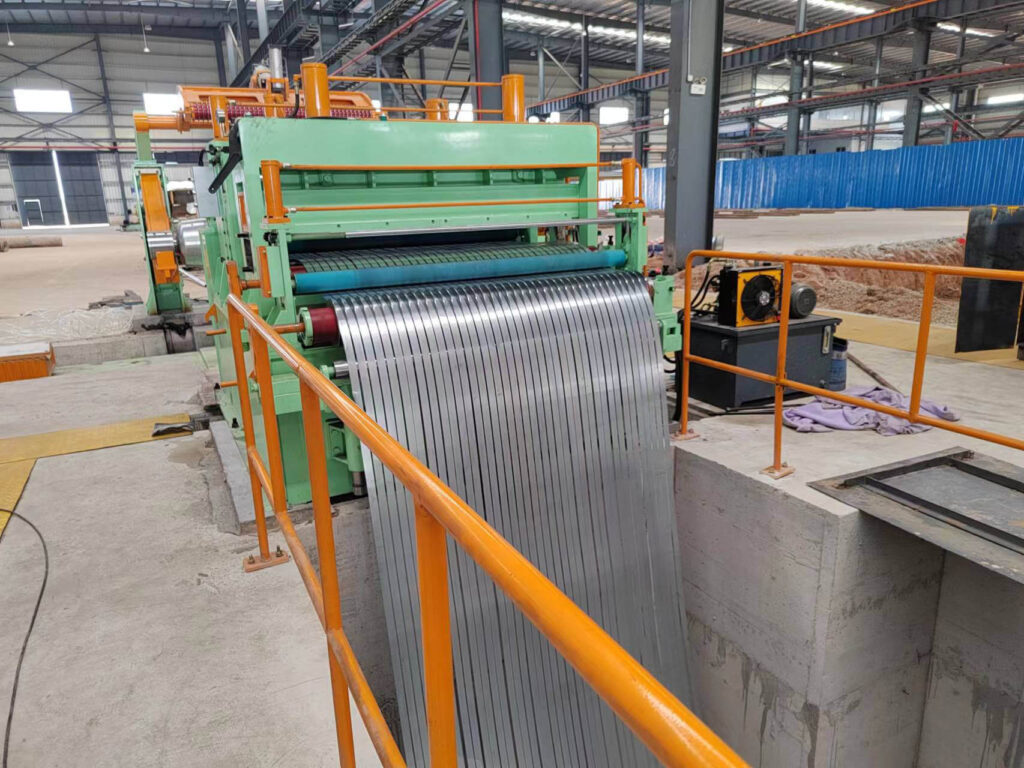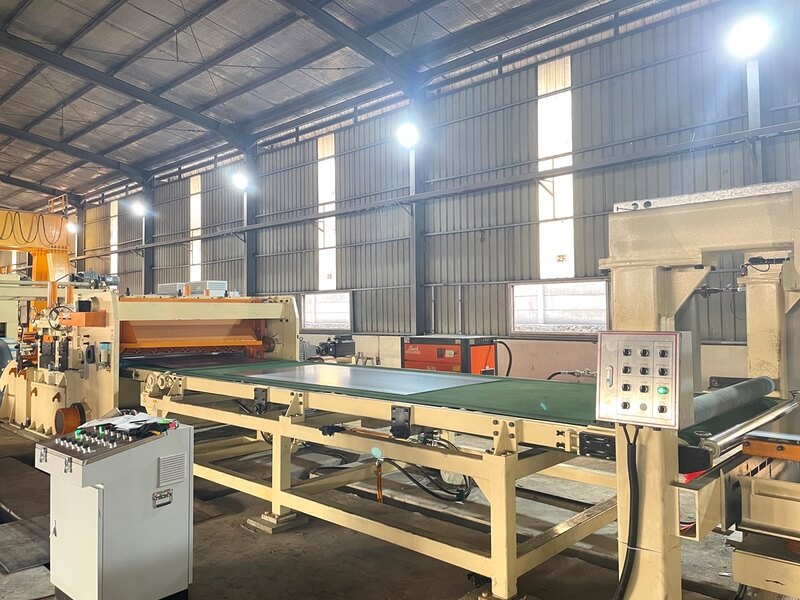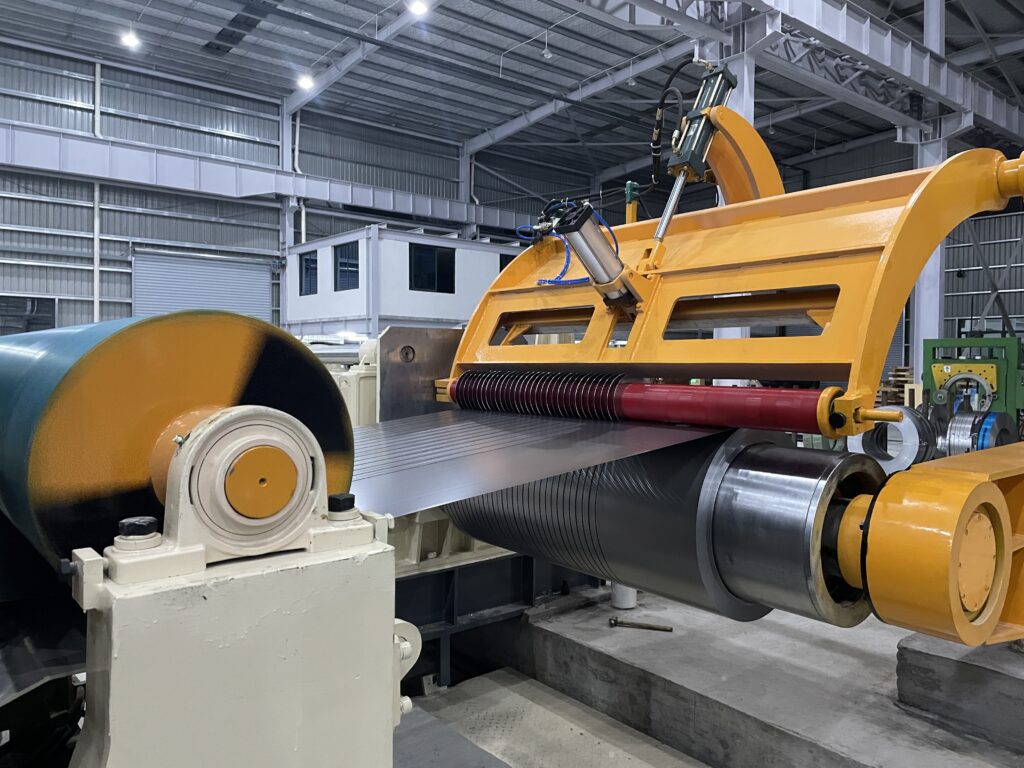Metal Slitting vs CTL Lines: Complete Technical Guide 2025
Expert comparison of metal slitting vs cut-to-length processing. MD series specifications, ROI analysis, setup procedures & troubleshooting for production managers.
The choice between metal slitting and cut-to-length (CTL) lines remains a pivotal decision for manufacturers aiming to optimize efficiency and precision in 2025. Metal slitting lines are engineered to transform wide coils into multiple narrow strips, preserving coil integrity while delivering exceptional width accuracy within ±0.1mm, ideal for high-volume applications such as automotive panel production and roll forming. Leveraging advanced servo-controlled rotary knife systems and multi-zone tension controls, these lines excel in maximizing material yield and throughput, as demonstrated by leading automotive manufacturers who reported up to a 40% increase in productivity using MaxDo’s MD-series slitting machines.
Conversely, CTL lines focus on producing flat, accurately cut sheets with flatness and length tolerances as tight as ±0.05mm, facilitated by multi-roll leveling units and precision shear systems essential for fabrication industries requiring flawless sheet surfaces for welding and machining. The integration of automation and smart sensor technology in CTL equipment enhances process control, reduces setup times, and supports just-in-time manufacturing strategies. When selecting between these processing paths, key considerations include your product mix, dimensional precision, material thickness (ranging from 0.3mm to 20mm depending on the line), and downstream process compatibility—factors that directly influence ROI and operational scalability in modern metal fabrication environments. MaxDo’s comprehensive equipment lineup and expert consultations enable manufacturers to tailor solutions that balance flexibility, precision, and throughput in alignment with evolving industry demands.
Understanding the Fundamental Technical Differences
How Metal Slitting Lines Operate
Metal slitting involves passing a wide coil through rotary circular knives that make longitudinal cuts, creating multiple narrower strips simultaneously. The process maintains the coiled format throughout, with each strip wound onto individual recoiler mandrels.

Core Technical Characteristics:
- Continuous processing: Material flows without stopping, enabling high throughput
- Multiple output streams: One wide coil produces several narrow strips in a single pass
- Preserved coil geometry: Strips maintain their coiled form for downstream processing
- Width flexibility: Easily adjustable for different strip widths within equipment limits
Optimal Applications:
- Tube and pipe manufacturing requiring continuous strip feed
- Roll forming operations for roofing, siding, and structural components
- Stamping operations where coil-fed parts increase production speed
- Applications requiring multiple widths from standard coil sizes
How Cut-to-Length Lines Function
CTL processing unwinds coiled material, passes it through leveling rolls to remove coil set, measures precise lengths, and cuts it into flat sheets using hydraulic or mechanical shears.

Essential Technical Features:
- Leveling integration: Multi-roll levelers eliminate coil memory and flatten material
- Precision measurement: Length measuring systems ensure dimensional accuracy
- Clean cutting: Hydraulic shears produce straight, burr-free edges
- Flat output: Sheets stack efficiently for handling and storage
Ideal Applications:
- Fabrication shops requiring flat blanks for welding and machining
- Laser cutting operations demanding flat material feed
- Construction applications needing large, flat panels
- Custom sheet sizes for specific project requirements
Critical Factors for Decision-Making
Material Specifications and Processing Capabilities
Thickness Range Considerations:
Different coil processing methods excel within specific thickness ranges based on their mechanical design and cutting/leveling capabilities.
For thin materials (0.3-3.0mm), slitting lines typically process faster due to lower cutting forces and simpler material handling. The MD-850 specifications show capability for this range with speeds up to 250m/min.
Medium thickness materials (1.5-6mm) can be effectively processed by both methods, with selection depending more on output format requirements than processing capability.
Heavy gauge materials (4-12mm) often favor CTL processing due to the substantial leveling forces required to flatten thick coils and the precision cutting needed for clean edges.
Width Requirements:
Your coil width determines equipment size requirements:
- Narrow applications (20-820mm): Compact equipment like the MD-850 configuration
- Medium width processing (300-1300mm): Mid-range equipment such as the MD-1350
- Wide coil processing (300-1650mm): Heavy-duty systems like the MD-1650
- Maximum width applications (300-2150mm): Industrial-scale equipment such as the MD-2200
Production Volume and Efficiency Analysis
High-Volume Continuous Operations:
Slitting lines excel in high-volume scenarios due to their continuous processing nature. Once set up, they run continuously without the start-stop cycles inherent in CTL operations.
Batch Processing Requirements:
CTL lines better serve operations requiring varied sheet lengths or when production runs involve frequent size changes.
Material Utilization Efficiency:
Slitting typically achieves higher material utilization since all cut material becomes usable product strips. CTL operations may generate edge trim and end cuts, though this varies by application requirements.
Quality and Tolerance Requirements
Dimensional Accuracy Needs:
CTL lines generally provide superior dimensional accuracy, particularly for length specifications. Modern servo-controlled systems can achieve tight tolerances essential for precision fabrication work.
Surface Quality Considerations:
Both processes can maintain good surface quality, but CTL leveling systems actively improve flatness characteristics that may be important for subsequent operations.
Edge Quality Standards:
Slitting produces slit edges with characteristics different from sheared edges. Your downstream processes may favor one edge type over another.
Practical Implementation Considerations
Setup and Changeover Requirements
Slitting Line Setup:
- Knife positioning for desired strip widths
- Individual strip tension calibration
- Recoiler mandrel positioning and alignment
- Separator ring adjustment to prevent strip contact
CTL Line Setup:
- Leveler roll adjustment for material thickness and hardness
- Length measurement calibration
- Shear blade alignment and clearance setting
- Stacking system configuration for sheet handling
Maintenance and Operational Factors
Slitting Line Maintenance:
- Regular knife inspection and replacement
- Recoiler mandrel and bearing maintenance
- Tension system calibration verification
- Strip guiding system alignment checks
CTL Line Maintenance:
- Leveler roll condition monitoring and replacement
- Shear blade sharpening and replacement schedules
- Length measuring system calibration
- Hydraulic system maintenance for cutting operations
Space and Infrastructure Requirements
Floor Space Considerations:
Slitting lines require space for multiple recoiler stations, while CTL lines need area for sheet stacking and handling systems.
Power Requirements:
Equipment power consumption varies significantly with size and capability. The MD series specifications show power requirements ranging from 138.5kW for compact units to 422.5kW for heavy-duty applications.
Making the Right Choice for Your Operation
Decision Framework
Choose Slitting When:
- Your downstream processes use continuous strip material
- You need multiple widths from standard coil sizes
- High processing speeds improve overall throughput
- Material utilization optimization is critical
- Your facility handles consistent, high-volume production runs
Choose CTL When:
- You require precise, flat sheets for fabrication
- Dimensional accuracy specifications are tight
- Your applications demand various custom lengths
- Downstream processes benefit from flat material input
- Production involves frequent size changes or custom orders
Hybrid Considerations
Some facilities benefit from both processing capabilities, either through dedicated equipment for different applications or flexible systems that can switch between modes based on production requirements.
Technical Specifications for Equipment Selection

MD Series Processing Capabilities
Based on documented specifications, the MD series offers comprehensive processing capabilities:
| Model | Working Width Range | Material Thickness | Processing Speed | Power Consumption |
|---|---|---|---|---|
| MD-850 | 20-820mm | 0.3-12mm | 1-250m/min | 138.5kW |
| MD-1350 | 300-1300mm | 0.3-12mm | 1-250m/min | 318.5kW |
| MD-1650 | 300-1650mm | 0.3-12mm | 1-250m/min | 422.5kW |
| MD-2200 | 300-2150mm | 0.3-12mm | 1-250m/min | 422.5kW |
These specifications provide a foundation for matching equipment capabilities to your specific processing requirements.
Performance Optimization Guidelines
Speed Optimization:
Maximum processing speeds depend on material thickness, width, and quality requirements. Thinner materials generally allow higher speeds, while thick or hard materials may require reduced speeds for optimal cut quality.
Quality Considerations:
Processing parameters must balance speed and quality based on your application requirements. Critical applications may justify reduced speeds to achieve superior edge quality or dimensional accuracy.
Implementation Success Strategies
Planning Phase Requirements
Facility Assessment:
- Available floor space and layout optimization
- Electrical power capacity and distribution
- Material handling system integration
- Safety compliance and worker protection measures
Production Analysis:
- Current material specifications and volume requirements
- Future capacity needs and expansion possibilities
- Integration requirements with existing equipment
- Quality standards and tolerance specifications
Installation and Startup Considerations
Infrastructure Preparation:
- Foundation requirements for equipment stability
- Utility connections including power, compressed air, and hydraulics
- Safety system integration and compliance verification
- Material flow optimization and handling system setup
Operator Training Requirements:
- Equipment operation procedures and best practices
- Safety protocols and emergency response training
- Quality control procedures and measurement techniques
- Preventive maintenance schedules and procedures
Long-Term Operational Success
Maintenance Program Development
Preventive Maintenance:
Establish systematic maintenance schedules based on equipment manufacturer recommendations and your specific operating conditions.
Performance Monitoring:
Implement systems to track key performance indicators including processing speed, quality metrics, and equipment efficiency.
Continuous Improvement:
Regular assessment of processing parameters and techniques can optimize performance and extend equipment life.
Future-Proofing Your Investment
In today’s fast-evolving metal processing landscape, choosing between metal slitting and cut-to-length (CTL) lines hinges on a strategic balance of production demands, precision requirements, and future scalability. Modern slitting lines, equipped with servo-driven rotary knives and multi-zone tension controls, excel in delivering high-throughput, multi-width strip outputs directly from wide master coils, thereby maximizing material yield and reducing waste—a critical advantage highlighted by industry leaders who have reported up to a 40% gain in operational efficiency using MaxDo’s MD-series slitting technology. Conversely, CTL lines stand out with their precision leveling and automated shearing systems that produce flat sheets with dimensional tolerances down to ±0.05mm, ideal for fabrication sectors that demand impeccable flatness and repeatable accuracy.
Optimal equipment selection must transcend basic capacity and accuracy metrics to incorporate automation integration, capacity margins for growth, and material versatility. Cases from automotive and appliance manufacturing illustrate how an adaptable CTL line powered by real-time quality monitoring and predictive maintenance can reduce downtime and increase throughput consistency, while flexible slitting setups enable quick job changes across varying coil specifications without sacrificing product quality. Investing in equipment with scalable control systems and robust automation ensures resilience against evolving market requirements and operational complexity.
Ultimately, success lies in a thorough analysis of your unique production volume, product mix, and facility constraints—backed by expert consultation that evaluates machine capabilities, future-proofing potential, and integration with plant-wide manufacturing execution systems. At MaxDo, this nuanced approach to equipment selection guarantees alignment with your strategic imperatives, delivering both technical excellence and sustained return on investment in 2025 and beyond.




